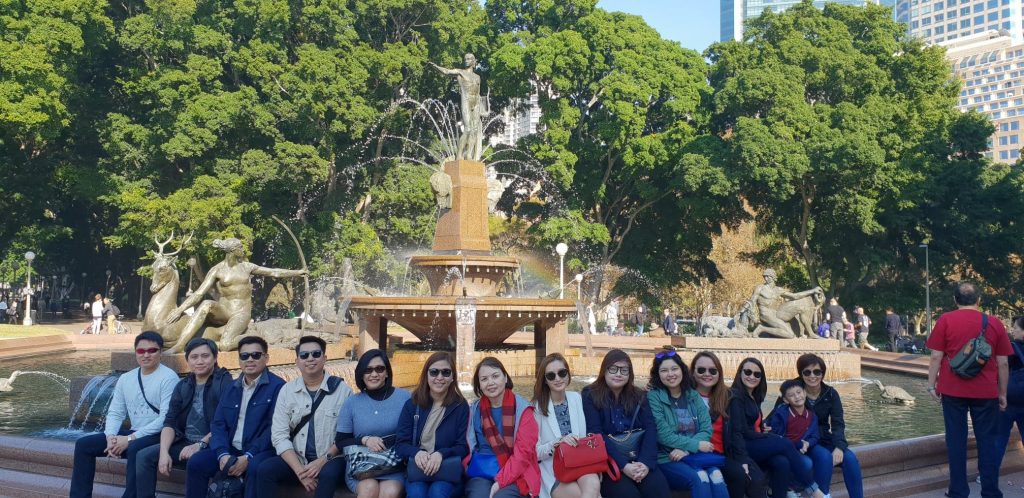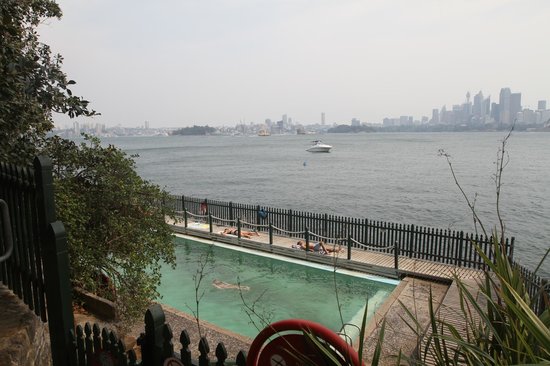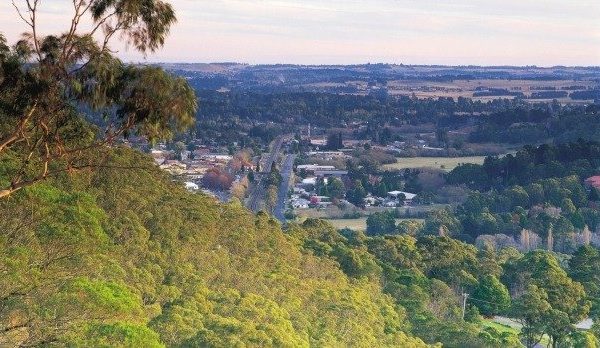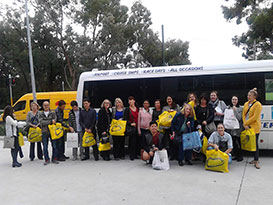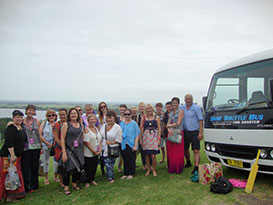Hyde Park and Archibald Fountain
Hyde Park in central Sydney was first established in 1810 by Governor Macquarie who named it after Hyde Park in London.
Prior to European settlement, the area of Hyde Park was a swamp marsh where the Indigenous hunted fowl
It was the site of a conflict between Indigenous people and settlers during the 1790s
During the early decades of the park, horse races were held and it was Sydney’s main cricket ground prior to the construction of the SCG at Moore Park.
During the mid-19th century, the park featured military drills, rugby union, cricket, and for some time, a zoo.
After 1854, the park’s theme changed, and local government sought to create it into an English themed garden
In 1857, the Hyde Park obelisk was built, which served as a sewer vent. Built in Victorian Egyptian style, the obelisk stands 22m tall and is currently a monument
Archibald Fountain
The Archibald Fountain at Hyde Park is located between the Elizabeth Street entry to St James Station and St Mary’s Cathedral.
The fountain was designed by Francois-Leon Sicard and was unveiled in March 1932
The fountain was built to commemorate the alliance between Australia and France during WW1.
Sicard, the designer, was heavily influenced by Classic Greek and Roman architecture. The fountain features the Theseus, the mythical king and founder of Athens, slaying the minotaur beast. The basin of the fountain is divided into three basins, one representing Diana, the goddess of purity, another symbolises the good things of the earth, and a third representing sacrifice for the public good.
War Memorial
Located at the southern end of Hyde Park is the Anzac War Memorial
Was unveiled in 1934, two years after the Fountain
Built specifically as a memorial to Australia’s involvement in World War I
Combination of Gothic and Art deco style architecture, the building features a main Silent Room with the bronze sculpture of a fallen soldier in the centre.
On the podium level of the building is the Hall of Memory
To the immediate north of the building is the Pool Of Reflection
St Mary’s Cathedral
St Marys is a Roman Catholic cathedral located in Sydney and is dedicated to Mary, mother of Jesus. It is a minor basilica.
The cathedral is the largest in Australia.
The first St Marys Cathedral was constructed in 1821 under the approval of Governor Macquarie and the first ever Catholic ministers to arrive in Australia, Father Connolly and Father Therry, who arrived from Ireland. The former church was smaller than the current and built in Gothic style. Unfortunately, it was destroyed by fire by 1865.
The current building was completed in 1882 under builder John Young, who built other Gothic style buildings around Sydney.
The church features ornate architecture throughout the building’s interior and exterior and dedications to Christian figures, including Jesus, Mary, the disciples and images along the walls of the Stations of the Cross. Within the cathedral is a chapel dedicated to the Irish saints. The chapel also features an underground crypt where church figures from the past are interred.
The spires on the cathedral’s towers were not included until 2000.
World Youth Day 2008 was held at St Mary’s, and Pope Benedict XVI visited the cathedral.
Royal Botanic Gardens
Description: The Royal Botanic Garden, Sydney is a heritage-listed major 30-hectare botanical garden, event venue and public recreation area located at Farm Cove on the eastern fringe of the Sydney central business district, in the City of Sydney local government area of New South Wales, Australia.
The Botanic Gardens was established by Governor Lachlan Macquarie in 1816, making it Australia’s oldest scientific institution.
Prior to the establishment of the Gardens, Farm Cove was the site of the colony’s first ever farm site, hence the name.
The Gardens are home to a wide variety of native and introduced plants. The Gardens also feature many different ponds that are home to ducks, koi fish and eels.
The sandstock fence on Farm Cove was built in the early 19th century by convicts and has stood for over two hundred years.
The Gardens featured a few themed sub-gardens within, including the Herb Garden near Macquarie Street and on the eastern side of the garden, the Succulent Garden which features desert plants. There is also a First Fleet Garden on the eastern side, which features different herbs and plants that were grown by colonists when a farm stood at Farm Cove.
A road train takes visitors through the gardens from the Opera House entry. The train costs a small fee and is an informative tour for visitors. There is also a visitors centre, where souvenirs are sold.
Many of the trees around the Gardens were what graced the Sydney area prior to colonisation. Much of the area that is now inner Sydney was thick forest, with the Tank Stream going through what is now Pitt Street.
Located within the Botanic Gardens is Australia’s oldest functioning bridge. The Macquarie Culvert was part of the original Mrs Macquarie’s Road which ran from what is now the Museum of Sydney to Mrs Macquarie’s Point. It was built in 1813, three years before the gardens opened, and is all that remains of the former road, now long gone.
At the Mrs Macquarie’s Point end of the gardens was where Queen Elizabeth disembarked on her visit to Sydney in 1954. A sandstock wall at the location commemorates the visit.
Somewhat erased from history is the fact that for a very short period of three years, from 1879-1882, on the Macquarie Street side of the gardens stood the magnificent Garden Palace. The Palace was built in 1879 for the Sydney International Exhibition and was based on London’s Crystal Palace. It was made of both wood and stone and featured a variety of artworks, plants and Indigenous artefacts. Unfortunately, the Palace mysteriously burnt down in 1882 and only the gates and fencing on Macquarie Street are what remains.
Queen Victoria Building
The Queen Victoria Building is a heritage-listed late-nineteenth-century building designed by the architect George McRae located at 429-481 George Street in Sydney
Address: 455 George St, Sydney NSW 2000 Opened: 21 July 1898
Construction started: 1893
Prior to 1893, a market stood on the site of what is now the QVB. It stood from 1820 to the 1880s and was where people went to purchase livestock/ The QVB was initially built to be a replacement market
The stone used to build the QVB was acquired from the now defunct quarries at Bowral and Waverley.
The architectural style of the QVB is Romanesque Revival, a popular style from the 19th century that mimicked the Roman architecture of the 11th-12th centuries.
In 1897 it was decided that the new building would be named in honour of Queen Victoria, the British monarch at the time.
The domes on the QVB were built by the Ritchie Brothers, a company who built railroads.
The QVB was originally built to be a market, replacing the former building on the site.
In the early 20th century, it housed the City of Sydney Library and local government facilities and by 1917, its tenancy capacity was full, and featured many different shops.
After construction was complete in 1898, the building underwent subsequent renovations in 1917, 1933, 1979 and 2006.
The QVB was declared Heritage Listed in 2010.
Today, at over 120 years old, the QVB is in pristine condition and is a must visit for shoppers of many different tastes. The QVB currently features many different restaurants and cafes and boutique clothing stores
Sydney Tower
Sydney Tower is Sydney’s tallest structure and the second tallest observation tower in the Southern Hemisphere. The tower opened in 1981 and took eleven years to complete. From 1981 to 2001, the tower was known as the Centrepoint Tower. Many Sydney locals still call it by that name.
Height: 305 m
Construction started: 1970
Floors: 19
Top floor: 268 m (879 ft) for Sydney Tower Skywalk
Cost: 36 million AUD (in 1981)
Did you know: After the Westfield Group took over ownership of Centrepoint in December 2001, the name was changed to Sydney Tower.
A popular revolving restaurant is located in the tower which offers pristine views of the entirety of Sydney
From 2000 to 2002, two steel sculptures of Olympic athletes stood at the peak of the Centrepoint Tower to commemorate Australia’s hosting of the 2000 Olympic Games. In 2003 the sculptures were removed; one is currently held at Sydney Olympic Park, and the other in Canberra.
The Westfield Shopping centre (which underwent renovations in 2009) beneath the Tower has been open since the 1970s before the tower was built. Currently it is home to many up-market boutique stores and clothing stores including General Pants, Connor, YD, GAP and Forever 21
The tower has featured in many Hollywood films, including Finding Nemo (2003), Power Rangers (1995) and Mission Impossible II (2000).
Enquire about our Icons of Sydney tour to see this famous landmarks of Sydney






